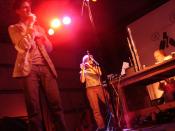Lucid dreaming is an issue that has been studied as far back as 1896. A Lucid dream
is one in which the dreamer is aware that he/she is dreaming and is sometimes able to take
control. Lucid dreams are an actual phenomena that do occur in REM sleep.
Dr. van Eeden was the first recorded person to study dreams in which the dreamer is
aware they are dreaming. In 1896 he began recording his dreams. Over a period of one
year he recorded 352 dreams, but only eight were lucid (Dreams 784).
The actual definition of a lucid dream, is a dream in which the dreamer mentally
awakens in the dream and becomes aware that it is only a dream. This 'awakening' is
usually triggered by the dreamer noticing something in the dream that is far too unusual to
be real (Blackmore 362). The actual term lucid dreaming was first used by the Dutch
psychiatrist Fredrick van Olen in 1913.
It simply means 'clear dreaming' (Blackmore
363).
Surveys and research have shown that 50 percent of all Americans have had at
least one lucid dream in their life that they could recall (Lucid Dreaming 365). When a
dreamer becomes lucid there are physical changes on the outside of the body and brain
patterns also change. There are usually pauses in breathing and changes in heart rate. The
amount of brain activity is more heightened than that of a regular dream, but less than
when waking. It has also been observed that a person having a lucid dream shows more
brain activity than a waking person under the influence of hallucinogenic drugs such as
LSD (Lucid Dreaming 364).
A lucid dream is usually provoked by an earlier day of heightened stress or anxiety
(Lucid Dreaming 364). They usually...


